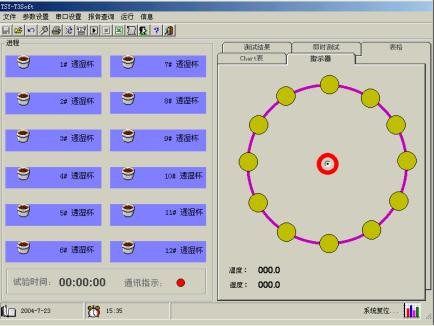称重法透湿性测试标准ASTM E96 概要
ASTM E96 是称重法测试标准之一,它不但详细介绍了在其它标准中常见的增重法(Desiccant Method),而且还介绍了在透湿性测试领域中与增重法具有同等地位的减重法(Water Method)。
1、称重法概要
称重法是一种独立的透湿性测试方法,测试原理简单明了:在规定的温度、相对湿度下,使试样两侧保持一定的水蒸气压差,测量透过试样的水蒸气量,计算透湿性相关参数。称重法可以分为渗透进入透湿杯的增重法和渗透离开透湿杯的减重法两种方法,它们的测试原理相同。
The purpose of these tests is to obtain, by means of simple apparatus, reliable values of water vapor transfer through permeable and semipermeable materials, expressed in suitable units. These values are for use in design, manufacture, and marketing.(进行这些试验是为了通过简单的设备获得可信的可渗透材料以及半渗透材料的水蒸气透过值。这些测试值将用于设计、生产以及商贸。)
2、增重法与减重法的测试原理
ASTM E 96将增重法和减重法都视为基础测试方法。The test methods are limited to specimens not over 11/4in. ( 32mm ) in thickness……Two basic methods, the Desiccant Method and the Water Method, are provided for the measurement of permeance.(这两种试验方法可用于检测厚度不大于 11/4in.(32mm)的试样……增重法和减重法两种基本方法都可以用来检测试样的水蒸气透过系数。)
In the Desiccant Method the test specimen is sealed to the open mouth of a test dish containing a desiccant, and the assembly placed in a controlled atmosphere. Periodic weighings determine the rate of water vapor movement through the specimen into the desiccant.(在增重法中,试样被密封在装有干燥剂的透湿杯杯口处,然后将整套透湿杯组件放在控制环境中。对透湿杯进行周期性称重来确定透过试样被干燥剂吸收的水蒸气透过率。)增重法测试原理可参见图1。

图 1. 增重法测试原理
In the Water Method, the dish contains distilled water, and the weighings determine the rate of vapor movement through the specimen from the water to the controlled atmosphere.(在减重法中,透湿杯中盛有蒸馏水,通过称重数据确定从蒸馏水一侧渗透通过试样进入控制环境中的水蒸气透过率。)图2 为减重法测试原理图。

图 2. 减重法测试原理
The vapor pressure difference is nominally the same in both methods except in the variation, with extremes of humidity on opposite sides.(两种测试方法的水蒸气压差相同,都是试样一侧极湿而另一侧极干,只是水蒸气压差相对于试样的方向有变化。)
这里需要对称重法的适用范围加以说明: ASTM E 96不仅适用于检测塑料薄膜、纸张、纤维板等包装材料的水蒸气透过率,而且还可以检测gypsum(石膏)、plaster products(石膏制品)、wood products(木材制品)的透湿性,因此标准中对试样的厚度要求非常宽松。对于很厚的试样,防止试样出现边缘泄漏是最重要的一点。但是在包材检测领域中很少会有很厚的试样,因此在之后的标准介绍中就不再涉及这种厚度过大的建材检测及其使用的相应设施,尽管这些也是ASTM E 96的一部分内容。
3、试验实现
进行称重法试验至少需要以下 3部分设备组件:透湿杯、测试环境、以及称重系统。
3.1 透湿杯
The test dish shall be of any noncorroding material, impermeable to water or water vapor. It may be of any shape. Light weight is desirable. A large, shallow dish is preferred, but its size and weight are limited when an analytical balance is chosen to detect small weight changes.(透湿杯应采用任何不腐蚀的、并且水或水蒸气无法渗透的材料。它可以是任意的形状。最好重量轻。首选透湿杯是大而浅的杯子,但是选定了用于检测微小重量变化的分析天平后它的尺寸和重量也就受到了一定的限制。)Different depths may be used for the Desiccant Method and Water Method, but a 3/4in. ( 19mm ) depth ( below the mouth ) is satisfactory for either method.(用于增重法和减重法的透湿杯深度可以不同,但一般深度在(杯口之下) 3/4in.(19mm)对于两种试验方法都很合适。)
如果试样容易皱折或是歪曲的话,需要在透湿杯杯口上加一个外缘或是支架以起到支撑试样的作用。一般情况下,过薄的试样多需要使用外缘或是支架来辅助试验。
3.2 测试环境
在 ASTM E 96中使用测试腔来实现测试环境,要求温度保持在±1℃之内,湿度保持在±2%RH之内。Air shall be continuously circulated throughout the chamber, with a velocity sufficient to maintain uniform conditions at all test locations.(应在测试腔中保持空气的持续循环,空气循环的速度应能足以保持所有的测试位置状态均一。)一般来讲,由于进行透湿性测试的试验温度多要高于实验室环境温度,所以采用单加热的方式来控温的比较多。
3.3 称重系统
ASTM E 96 中是采用分析天平对透湿杯进行称重的,当然也可以采用其它的称重方式。标准中对分析天平的灵敏度有一定的要求:The balance shall be sensitive to a change smaller than 1% of the weight change during the period when a steady state is considered to exist.(当认为水蒸气的渗透已经进入稳定状态后,天平对重量变化的灵敏度要小于在一段时间内重量变化的1%。)因此,如果你采用的分析天平的灵敏度较高,那么相应的称重间隔时间就可以比较短,如果你采用的分析天平的灵敏度较低,相应的称重间隔时间就要延长了很多。采用高精度分析天平或是其它的高精度称重系统,对提高试样的透湿性测试精度以及缩短试验时间都是有益的。
4、制样
The material shall be sampled in accordance with standard methods of sampling applicable to the material under test. The sample shall be of uniform thickness. If the material is of nonsymmetrical construction, the two faces shall be designated by distinguishing marks.(应按照当前试样的相关取样标准进行材料试样的制取。试样应厚度均一。如果试样为非对称结构,应使用指定符号对试样两面加以区分。)Test specimen shall be representative of the material tested.(测试试样应该能够代表当前测试的材料。)在ASTM E 96 中对在不同情况下的试样制取数目以及试验方式都有详细规定。
Attach the specimen to the dish by sealing ( and clamping if desired ) in such a manner that the dish mouth defines the area of the specimen exposed to the vapor pressure in the dish. Thoroughly seal the edges of the specimen to prevent the passage of vapor into, or out of, or around the specimen edges or any portion thereof.(通过密封(如果需要可用夹紧方式)将试样与透湿杯装夹在一起,这样透湿杯的杯口就确定了试样的试验面积。完全密封试样的边缘以防止水蒸气进入、离开、在试样边缘周围或它的任何部分。)
试样装夹效果的好坏将直接影响到试验结果的准确性,其中最关键的一点就是试样边缘的密封。蜡封和使用密封圈密封是常用的两种密封方式。
蜡封工艺比较复杂,先要按照一定的比例配制密封蜡,并将配制好的蜡加热到熔化状态,再将蜡浇灌到透湿杯的边缘处以密封试样,待蜡冷却定型后再清理透湿杯的边缘。应当特别注意的是当密封蜡的配制成分不同时,在试验过程中蜡的挥发重量也不相同,这就会直接影响试验结果的准确性。
密封圈密封的适应性、可操作性要比蜡封好的多。Gasketed types of seals are also in use on appropriately designed dishes. These simplify the mounting of the specimen, but must be used with caution, since the possibility of edge leakage is greater with gasketed seals than with wax seals.(使用密封圈的密封方式在一些设计适当的透湿杯中也有应用。这简化了试样的装备,但应小心使用,因为使用密封圈的密封方式出现边缘泄漏的可能性比使用密封蜡要大。)
装夹完成的试样可参见图 4。

图 4. 减重法试样装夹示意图
5、试验过程
整个试验过程可以分为试样的平衡、进行周期性称重以判断试样是否已经达到了渗透平衡,当试样达到渗透平衡后即可停止试验。
5.1 增重法的试验过程
Fill the test dish with desiccant……Leave enough space so that shaking of the dish, which must be done at each weighing, will mix the desiccant. Attach the specimen to the dish and place it in the controlled chamber……Weigh the dish assembly periodically, often enough to provide eight or ten data points during the test. At first the weight may change rapidly; later a steady state will be reached where the rate of change is substantially constant.(向透湿杯中添加干燥剂……留出足够的空间以满足摇动透湿杯混合杯内干燥剂的目的,这一步是每次称重都必须要做的。将试样装夹在透湿杯上,并将装夹有试样的透湿杯放进测试腔中……对透湿杯进行周期性称重,需要在整个试验中获得8到10组数据。一开始重量可能会迅速变化;之后会达到一个(渗透)稳定的状态,这时的变化率就非常稳定了。)
5.2 减重法的试验过程
Fill the test dish with distilled water……The air space thus allowed has a small vapor resistance, but it is necessary in order to reduce the risk of water touching the specimen when the dish is handled. Such contact invalidates a test on some materials such as paper, wood, or other hygroscopic materials. Attach the specimen to the dish. Weigh the dish assembly and place it in the controlled chamber on a true horizontal surface.(向透湿杯中添加蒸馏水……留出的空气隙可有很小的水蒸气阻抗性能,但是空气隙的存在可减小在处理透湿杯时水接触到试样的风险。这种接触可以使得对一些材料的试验直接无效,例如纸张、木材、以及其它吸湿性材料。将试样装夹在透湿杯上。称量试样、透湿杯组合的重量并将它放置在测试腔中绝对水平的表面上。)之后的试验过程与增重法完全一致:对透湿杯进行周期性称重,直至重量变化率保持恒定。
5.3计算结果
ASTM E 96将试验过程分为增重法和减重法两部分介绍,但是数据处理方法是一致的。
Calculate the water vapor transmission, and permeance as follow.(按照下式计算水蒸气透过率和水蒸气透过系数。)

- G = weight change ( from the straight line ), g(从直线段获得的重量变化量,单位是g)
- t = time, h(时间,单位为h)
- G/t = slope of the straight line, g/h(直线段的斜率,单位是g/h)
- A = test area ( cup mouth area ), m2(测试面积(杯口面积),单位是m2)
- WVT = rate of water vapor transmission, g/h·m2(水蒸气透过率,单位是g/h·m2)

- p = vapor pressure difference, mmHg(水蒸气压差,单位是mmHg)
- S = saturation vapor pressure at test temperature, mmHg(在试验温度下的饱和蒸汽压,单位是mmHg)
- R 1 = relative humidity at the source expressed as a fraction ( the test chamber for desiccant method; in the dish for water method )(在水蒸气一侧的相对湿度,表示为百分数(对于增重法是指测试腔中的相对湿度,对于减重法是指透湿杯中的相对湿度))
- R 2 = relative humidity at the vapor sink expressed as a fraction(在水蒸气吸收侧的相对湿度,表示为百分数)
处理数据通常有两种方式:一种是图形分析,另一种是数字分析。当然现在结合最先进的计算机数据分 析处理,不但可以将精确称重采点的间隔无限缩小,更能“图文并茂”地进行数据分析, Labthink TSY-T1和TSY-T3的监控软件(参见图5)不但具有强大的数据分析采集功能,而且还具有作图、数据统计分析等功能。

图 5. Labthink TSY-T3监控软件
6、注意事项
6.1 测试环境的选择
A permeance value obtained under one set of test conditions may not indicate the value under a different set of conditions. For this reason, the test conditions should be selected that most closely approach the conditions of use.(在一组试验条件下得到的水蒸气透过系数值不一定能表示试样在其它不同的试验条件下的水蒸气透过系数值。因此,所选择的试验条件应该是最接近实际使用条件的。)在ASTM E 96的附录中给出了几组标准的试验条件以供用户选择。
6.2 试样装夹可能引起误差
When the specimen area is larger than the mouth area, this overlay upon the ledge is a source of error, particularly for thick specimens. The overlay material results in a positive error, indicating excessive water vapor transmission. The magnitude of the error is a complex function of the thickness, ledge width, mouth area, and possibly the permeability.(当试样面积大于杯口面积时,试样在透湿杯边缘的覆盖就成为一个误差来源,尤其是对于较厚的试样。试样覆盖将导致一个正向误差,表示有额外的水蒸气透过。误差的大小是试样厚度、边缘宽度、杯口面积、可能还包括水蒸气透过量的综合影响。)
6.3 试验时间
早期的称重法设备采用的分析天平普遍精度不高,而且人工操作的称重过程可能会给试样的渗透平衡造成一定的影响(如果称重过程能在测试环境中完成的话,这种影响将小一些),因此使用早期称重法设备的测试时间一般较长,一个中阻隔试样的试验时间往往就要长达几天。如今的全自动称重法透湿仪通过改良称重过程使其不但能在控制环境中完成而且可由设备自动实现,并采用高精度测重元件,完成同种中阻隔试样的时间也就是几小时。
6.4 dummy试样
When results of water vapor transmission are expected to be less than 0.05 perm, a dummy specimen is strongly recommended. Such a dummy specimen should be attached to an empty cup in the normal manner. The environmental effects of temperature variation and buoyancy variability due to barometric pressure fluctuation can be arithmetically tared out of the weighing values. This precaution permits earlier and more reliable achievement of equilibrium conditions.(如果预计试样的水蒸气透过系数低于0.05 perm(本标准中1 perm是5.7×10 -11 kg/Pa·s·m2),强烈推荐使用dummy试样。将试样按照通常的装夹方法装夹在空透湿杯上。温度变化以及由于大气压变化引起的浮力变化的这些环境影响可以在称重数据中去除掉。这样做可使得判断进入平衡状态的时间更早而且更加可靠。)As a further precaution when gasketed seals are used instead of preferred sealants, a blank test run is suggested using glass or metal as a dummy specimen.(当使用密封圈来代替首选的密封剂,建议使用玻璃或是金属作为dummy试样进行空白试验。)
7、总结
ASTM E 96是目前编写最全面的称重法测试标准之一,现做简要总结:称重法分为增重法和减重法两种,它们的测试原理相同;透湿杯、测试环境、称重系统是完成称重法的三大主要元件,缺一不可;试样装夹过程繁杂,装夹效果却直接影响试验结果;dummy试样的试验结果对试验结果的分析及计算影响很大,采用专业软件将提供强大的数据分析功能。
文章地址:http://service.labthink.cn/cn/article-Permeation-info-11011862.html
版权所有 Labthink兰光 未经许可禁止转载 转载请注明出处

